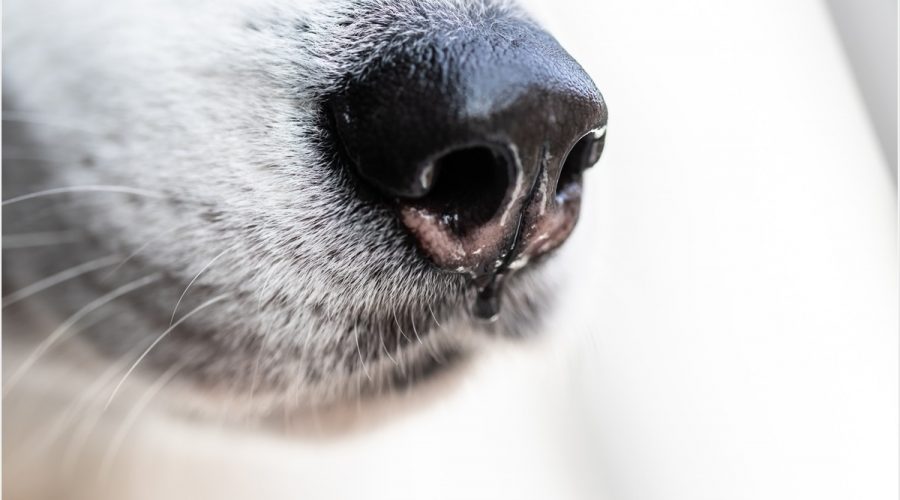Sniffer dogs detect long COVID after 1.5 years
In a recent study published on the medRxiv* preprint server, researchers used sniffer dogs to test the presence of volatile organic compounds (VOCs) triggered by severe acute respiratory syndrome coronavirus 2 (SARS-CoV-2) infection in axillary sweat samples of long coronavirus disease 2019 (COVID-19) patients.

Study: Screening for SARS-CoV-2 persistence in Long COVID patients using sniffer dogs and scents from axillary sweats samples. Image Credit: Artem Orlyanskiy / Shutterstock.com
Background
Due to the presence of the Jacobson vomeronasal organ and 40 times more olfactory cells in dogs, these animals have olfactory capacities that are estimated to be several hundred times greater than that of humans. Dogs are highly intelligent animals and can be trained to detect several different substances of biological origin, including human odors.
Trained sniffer dogs have detected VOCs triggered by COVID-19 during the initial phase of the disease. Preliminary studies have documented the presence of viral ribonucleic acid (RNA) and proteins in olfactory slots, digestive tissue sections, and the brain of long COVID patients. Therefore, it is of great scientific interest to assess whether dogs can also identify SARS-CoV-2 in odor samples of long COVID patients.
About the study
For the present study, researchers used axillary sweat samples of patients who had long COVID, wherein they had a symptomatic initial episode of COVID-19 which was followed by prolonged symptoms corresponding to the 2021 World Health Organization (WHO) definition of the post-acute COVID syndrome (PACS).
The veterinarians of the National Veterinary School of Alfort (ENVA) trained dogs to sniff VOCs and detect the presence of SARS-CoV-2 in the sweat samples of long COVID patients. The researchers asked these patients to apply a sterile surgical swab under each armpit for five minutes to take an axillary sweat sample at home, put them into a freezer bag, seal them, and send it to ENVA by mail.
At ENVA, following the Nosaïs procedure, patient swabs were placed in a glass container in an olfaction detection cone. The researchers tested a total of five cones for the presence of SARS-CoV-2, where each cone had one positive swab from a long COVID patient and four negative swabs from COVID-19 negative and asymptomatic patients.
All test cones were placed at random locations. Two trained sniffer dogs and their handlers went to the sample location, where the dogs sniffed and discriminated positive samples from the negative ones to confirm the presence of SARS-CoV-2.

Dog sniffing setting: A handler is responsible for the guidance of the dog. The sniffing cone helps the dog sniff the scent of the samples put inside glass containers, which are held in empty boxes.
Study findings
Between May and October 2021, a total of 45 long COVID patients, 73.3% of which were female and had a median age of 45 years, sent their samples to ENVA, These patients had lingering symptoms such as intense fatigue, diarrhea, ear, nose, and throat (ENT) disorders, as well as neurocognitive disorders for an average of 15.2 months.
Before vaccination, 24.4% of patients tested seropositive at least once for COVID-19, whereas 64.4% were seronegative. Notably, 11.1% of the sample donors did not present their serology results.
The sniffer dogs successfully discriminated 51.1% (23/45) of long COVID samples in a positive way, while they did not discriminate the control samples positively or negatively. The rate of positive discrimination in subjects with positive SARS-CoV-2 serology and negative SARS-CoV-2 serology was 36.4% and 55.2%, respectively.
For the first time, a study with long COVID patients showed that dogs could detect VOCs up to 1.5 years after the initial phase of COVID-19. This suggests that SARS-CoV-2 is persistently present, at least in some long COVID patients.
Consistent with the findings of previous studies, the specificity of SARS-CoV-2 olfactory detection by dogs in this study was strikingly high. The canine detection test outlined in this study supported the hypothesis that the virus present in the sweat samples of at least some long COVID patients not only persists but actively replicates.
Conclusions
Overall, the study demonstrated a unique, sensitive, and non-invasive test using canines to detect the presence of SARS-CoV-2 infection. This test is especially useful during the acute phase but could also be used in extended phases of the COVID-19 illness.
Moreover, this identification approach provides holistic and reliable results of the existence of a persistent infection faster than the COVID-19 reverse transcription-polymerase chain reaction (RT-PCR) test. Furthermore, this test also works when the precise location of the virus reservoir in the body is not known.
The nature of the VOCs triggered by SARS-CoV-2 infection is under investigation by several international laboratories in different countries. Using these better characterized VOCs, improvised odor sampling methods and point-of-care instruments may be developed in the future. These types of advancements may also assist in the development of similar odor-based detection tests for other human pathogens.
*Important notice
medRxiv publishes preliminary scientific reports that are not peer-reviewed and, therefore, should not be regarded as conclusive, guide clinical practice/health-related behavior, or treated as established information.
- Grandjean, D., Slama, D., Gallet, C., et al. (2022). Screening for SARS-CoV-2 persistence in Long COVID patients using sniffer dogs and scents from axillary sweats samples. medRxiv. doi:10.1101/2022.01.11.21268036. https://www.medrxiv.org/content/10.1101/2022.01.11.21268036v1.
Posted in: Medical Science News | Medical Research News | Disease/Infection News
Tags: Brain, Coronavirus, Coronavirus Disease COVID-19, covid-19, Diarrhea, Ear, Fatigue, Olfaction, Polymerase, Polymerase Chain Reaction, Respiratory, Ribonucleic Acid, RNA, SARS, SARS-CoV-2, Serology, Severe Acute Respiratory, Severe Acute Respiratory Syndrome, Syndrome, Throat, Transcription, Veterinary, Virus

Written by
Neha Mathur
Neha Mathur has a Master’s degree in Biotechnology and extensive experience in digital marketing. She is passionate about reading and music. When she is not working, Neha likes to cook and travel.
Source: Read Full Article
